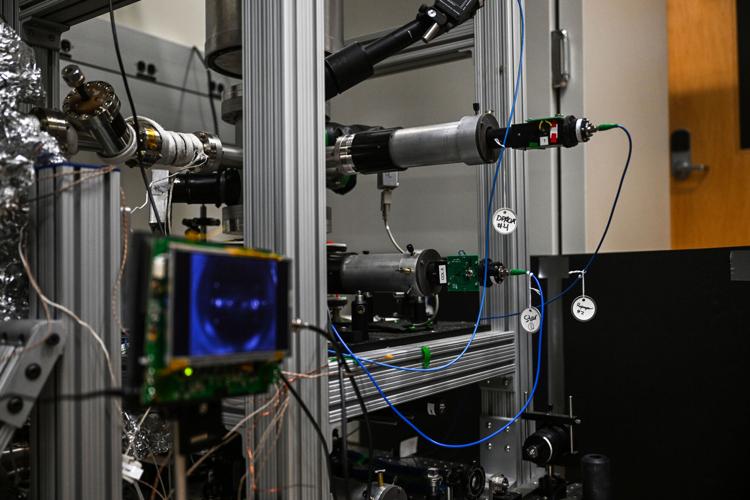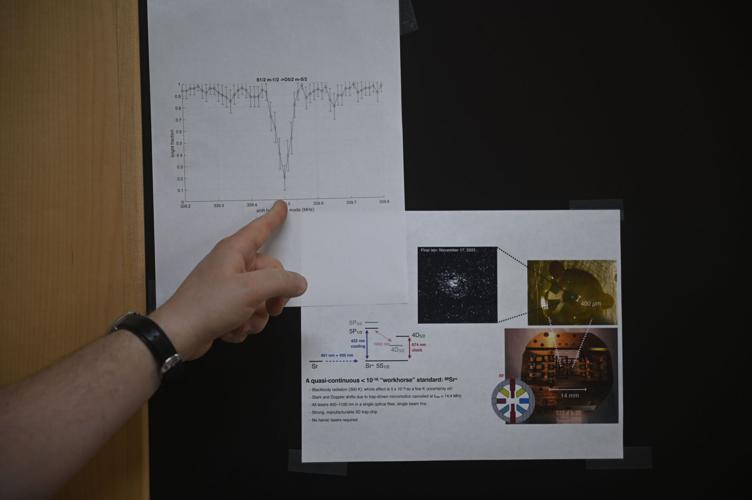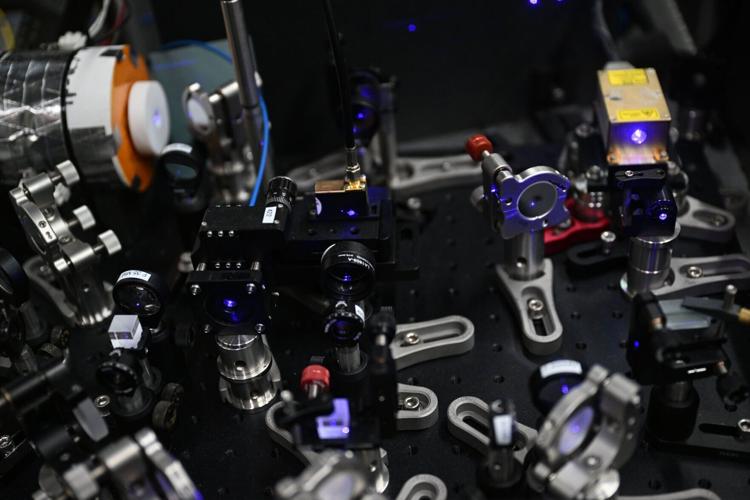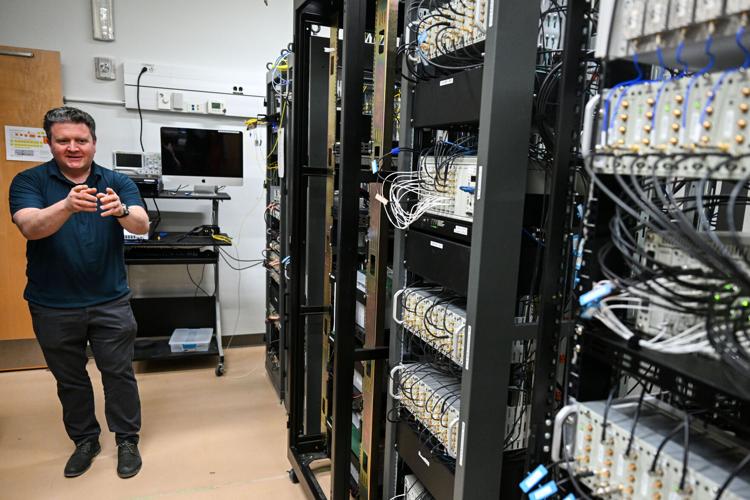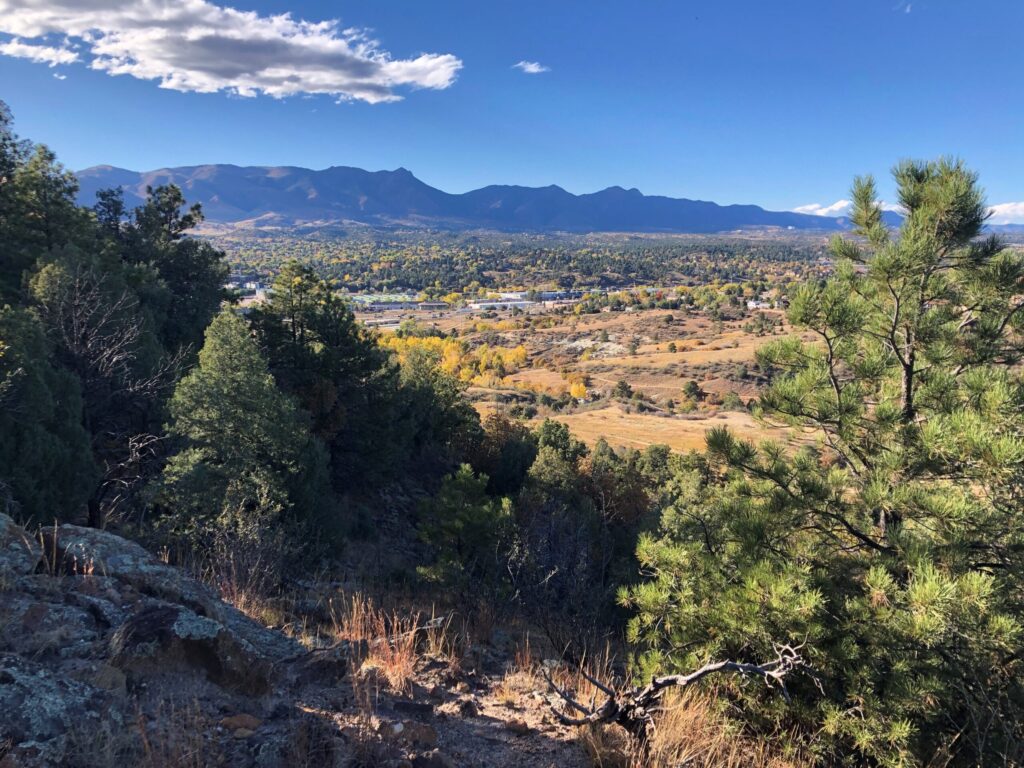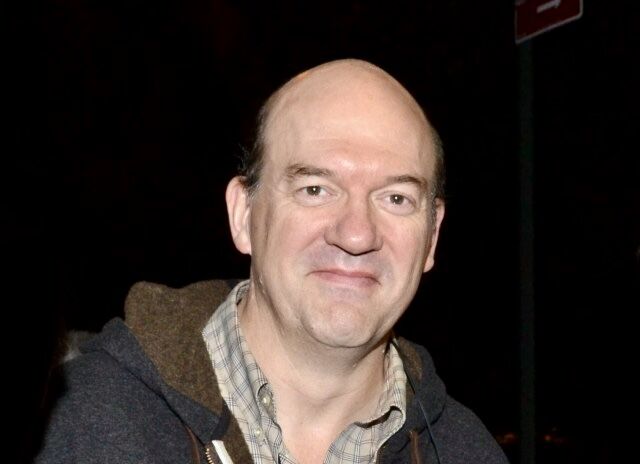‘The most precious, non-renewable resource’: The study of time is core at NIST
BOULDER • Every second in a small laboratory room in Boulder, a green light flashes.
Within the webs of yellow wire and shelves of computer systems, this green light represents the passage of time. But the moment our eyes realize it, its mission has been completed.
Here, time ticks precisely. Home to the National Institute of Standards and Technology (NIST), this is a place where scientists research time, from developing atomic clocks to investigating more abstract concepts.
Before the NIST, measurements varied widely depending on location, and the differences often caused confusion in commerce. Consumers would seldom get fair deals. So in 1901, as the Industrial Age boomed, Congress established the institute as a means to universalize measurements across the country, creating standards for electricity, mass, temperature, light and time.
“This was a necessity,” said Rebecca Jacobson, the public outreach coordinator for the Boulder facility.
While the original facility was built in Washington D.C., in 1954 the operations were moved to Boulder in response to the Cold War. Since then, scientists have used the facility to study precision in measurement.
Tick, tock, tick, tock
Time here is measured at the atomic level.
Meet NIST supervisory physicist Jeffrey Sherman. Sherman maintains and researches NIST systems, like atomic clocks, that produce official U.S. time.
Now, buckle up for some science. Simply put, an atomic clock measures time based on the vibrations of an atom. The first usable atomic clock was developed in 1955 by British physicists Louis Essen and Jack Parry with a cesium beam device.
Over time, scientists developed a more accurate atomic clock using cesium atoms, which has defined the second since 1967. That’s the standard that scientists (and just about everyone else) use around the world.
“The cesium atom, for example, in Boulder, Colo., ticks at the same rate as the cesium atom does in Paris or on Mars,” Sherman said. “So if you set the cesium atom into vibration, just like a pendulum, and you commit to counting oscillations of the vibration forever, never missing one, never double counting, then two people doing the same procedure will count the same rate, and when you convert that count into a time, they’ll come up with an answer that’s the same.”
The device used to measure these frequencies is called a cesium fountain, which Sherman described as a “tuning fork for microwave radiation.”
It’s a long metal tube, inside of which a cloud of about 100,000 cesium atoms float in a vacuum chamber. With the help of several laser beams and magnetic fields, the cesium atoms absorb and emit microwave radiation with a specific frequency.
From this device, atomic clocks count — wait for it — 9,192,631,770 of those electromagnetic wave peaks. The time it takes to count that number of microwaves is the internationally recognized unit of the second — a bit more accurate than the “one Mississippi, two Mississippi” method. Why that value? Complicated math. But ultimately, it corresponds to the original notion of number of seconds in terms of a fraction of a year.
At NIST, there are two almost continuously operating cesium atomic fountains.
“The virtue of the tuning fork is it reproduces rate as absolutely as you can design it. The idea is, by ringing that instrument as often as possible, it calibrates the 20 clocks online by teasing information out of the cesium atom,” Sherman said.
“It’s ephemeral. So when you make an SI second, the very next thing they’re going to want from you is another one and another one and another one. And hence the whole continuously running clock.”
A couple of rooms over from the fountain are the clocks, filling shelves with heavy equipment, wires and flashing lights. The facility in Boulder is home to 20 of the world’s roughly 400 atomic clocks.
“We try to count oscillations out of an atom forever, never stopping,” Sherman said. “Of course, any physical clock you make will eventually break for one reason or another. So we don’t run just one. We run about 20, and we take an average every 12 minutes.”
Computers record an average to detect potentially failing clocks.
By using this method, scientists like Sherman can report time precisely, down to the 13th decimal point of a second.
One of the ways NIST distributes time is through the Network Time Protocol. Each day, the institute receives about 100 billion requests for time using this system. This gives accurate time to devices like cable modems and home computers.
“It’s so popular because it was one of the first and so it got built in as a dependency to a lot of manufacturers’ devices. So a lot of users don’t really know they’re using it,” Sherman said.
You can see the true precision of these atomic clocks by using your phone or computer and visiting time.gov. That site, run by NIST, will tell you how slow or fast your device’s clock is running in comparison to Coordinated Universal Time, measured by atomic clocks.
What is time?
Since our beginning, humans have sought systems to measure time.
Until the 20th century, people relied primarily on the skies to tell time, including the sun and moon, the planets and stars, Sherman said. But as the pendulum clock mechanisms improved in the late 1920s, people realized the rotation of Earth was not as stable as previously thought.
“The Earth would speed up, it would slow down. There were seasonal variations,” he said. “It was really with the advent of these better oscillators that it was the first challenge to this astronomical sense of time. There was something else you could count, which was swings of a pendulum, and it was also universal.”
These days, quartz crystal oscillators are the clocks of choice, which work similarly to pendulums, but instead of gravity, their intervals are measured by the vibrations of the electromagnetic field interacting with quartz.
“In a way, an atomic clock is not much different. It’s in this same spirit of smaller objects, faster vibrations, and also constructed less and less by humans, but more and more by nature,” Sherman said.
Working in the lab surrounded by questions of space and time, scientists can quickly fall into a philosophical hole of “What is time?”
“Don’t be shocked if you find physicists that aren’t all that excited about atomic clocks, because they are excited by these more fundamental cosmological questions,” Sherman said. “But I think in our corner of space-time, it’s incredibly useful to run the mechanical or atomic oscillators.”
Even Sherman admits there’s some level of arbitrariness to it, though, especially when thinking about the origin of the universe and the Big Bang Theory, before atoms were even formed.
“Even in principle, you cannot imagine continuing a cesium oscillation beyond the point where cesium atoms didn’t exist,” he said.
“In some sense, choosing an atom, keeping track of its oscillations, is a human element, a human system imposed to try and accumulate time by a physical thing we can count — and it has its limits.”
Theoretical physicist Bijunath Patla grapples with these concepts often.
“When people say time, what they mean is the arrow of time. That’s what differentiates between past, present and future,” Patla said.
“There is one existing time that we all define. It’s a time that an ideal clock would tick in the universe, if nothing existed, it would just keep ticking from beginning to end exactly the same way. But that clock doesn’t exist.”
His research at NIST centers around how gravity impacts the passage of time, including on the moon and Mars. While the actual measurement of time intervals can be boring, Patla said, the studying of time at the atomic level can help us better understand the universe.
“These small time intervals tell you something about profoundly about the universe that you would otherwise not know,” Patla said.
Days to hours, minutes to seconds …
Across the hall from the atomic clocks is the promise of even more precision.
Sherman and his colleagues are designing and studying optical clocks, which use laser beams instead of microwaves to provide a measurement for time. These clocks count the vibrations of optical beams, which are about 100,000 times faster than a microwave.
He described the optical clocks as “next-generation versions of the tuning fork.”
“I know this looks like a mad science experiment, but relatively this is as simple as it gets,” Sherman said as he pointed to the stage of wires and lasers.
“The goal of this project is to sort of choose the simplest possible optical standard to help make the transition as the second is redeveloped.”
While still in their development phase, the optical clocks promise a factor of 1,000 improvement from cesium fountains.
So, what could we gain from more precise measurements? Well, the higher precision clocks would make GPS services even more accurate, Sherman said, improving new technology like self-driving vehicles and telecommunications.
“There’s always efficiencies to be gained or capabilities you could have, if and only if you have widespread synchronization,” he said.
And while time is his focus, Sherman acknowledges time is more a means to an end.
“Navigators who invented precise clocks to take on ocean liners didn’t really care about the time. They knew when the sun rose and the sun set, but it was used to determine their longitude. So even then, time was just a means to an end,” he said. “It’s a technological input, but not the prime star of the show.”
Even as the atomic clock ticks with notable precision, physicists like Sherman are always on the front lines of discovery.
“In one sense, time is the most precious nonrenewable resource driving all these technologies, technologies that span continents, markets, telecom. So it only makes sense to have some kind of international synchronized standard,” Sherman said.








